Hey everyone! I made this video to help people grade their footage from the Evo. In it I give an explanation for why you should shoot in log and how to grade it. Enjoy!
You are using an out of date browser. It may not display this or other websites correctly.
You should upgrade or use an alternative browser.
You should upgrade or use an alternative browser.
How to grade LOG footage, any why you should shoot in it!
- Thread starter Rocco Germani
- Start date
What are your recomended settings to export Autel 10 bit 4k 30fps files in Premiere pro?Hey everyone! I made this video to help people grade their footage from the Evo. In it I give an explanation for why you should shoot in log and how to grade it. Enjoy!
Set your quality to lossless, matching the original settings.What are your recomended settings to export Autel 10 bit 4k 30fps files in Premiere pro?
skrano
Member
- Joined
- Nov 17, 2020
- Messages
- 12
- Reaction score
- 17
(Out of the topic) I definitely think that lut profile that autel gave us, is totally embarassing compared to others luts. Guess they made it with a 200$ lcd notebook.
Your video is good Rocco, just some "minor upgrades" in terms of recording are suggested.
Your video is good Rocco, just some "minor upgrades" in terms of recording are suggested.
GeoDrone SRL
Well-Known Member
- Joined
- Aug 18, 2021
- Messages
- 490
- Reaction score
- 273
- Age
- 48
REC 709 color profile - as you use LOG and you need to process it to REC 709 with color grade or LUT.What are your recomended settings to export Autel 10 bit 4k 30fps files in Premiere pro?
For further editing use:
Highest quality
H265
Profile: MAIN, 6.1
CRB: 120 MPBS
Highest quality
Optical Flow.
For delivery to client, use H264 as many clients don't deal with H265 and CBR: 60 MBPS is enough.
Cheers.
Saladshooter
Well-Known Member
- Joined
- Aug 25, 2021
- Messages
- 182
- Reaction score
- 177
- Age
- 52
The problem I have with my EVO 2 LOG footage is that I can't get rid of the unnatural blue cast to the shadows. Its present unless I absolutely crush the details. I can balance the color temperature better or tune the colors with the X-Rite color corrector and get the same results. It also can't be corrected by simply reducing blue levels as that hurts the image in other areas.
I have watched many of the EVO 2 Pro videos posted here and on Youtube and see the same issue crop up in the same spots. I've attached a sample grabbed from my videos. The color of the overall shot looks good to my eye but the shadows are way off. Any suggestions?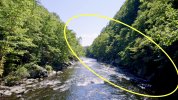
I have watched many of the EVO 2 Pro videos posted here and on Youtube and see the same issue crop up in the same spots. I've attached a sample grabbed from my videos. The color of the overall shot looks good to my eye but the shadows are way off. Any suggestions?

Thanks. Wery helpful. Did you try also HDR 10Bit in log? How to export HDR to get bright picture?REC 709 color profile - as you use LOG and you need to process it to REC 709 with color grade or LUT.
For further editing use:
Highest quality
H265
Profile: MAIN, 6.1
CRB: 120 MPBS
Highest quality
Optical Flow.
For delivery to client, use H264 as many clients don't deal with H265 and CBR: 60 MBPS is enough.
Cheers.
herein2021
Well-Known Member
The problem I have with my EVO 2 LOG footage is that I can't get rid of the unnatural blue cast to the shadows. Its present unless I absolutely crush the details. I can balance the color temperature better or tune the colors with the X-Rite color corrector and get the same results. It also can't be corrected by simply reducing blue levels as that hurts the image in other areas.
I have watched many of the EVO 2 Pro videos posted here and on Youtube and see the same issue crop up in the same spots. I've attached a sample grabbed from my videos. The color of the overall shot looks good to my eye but the shadows are way off. Any suggestions?View attachment 11646
All you have to do is warm up the lows vs changing the WB. That will fix it in 2 seconds and not affect the mids or highs.
REC 709 color profile - as you use LOG and you need to process it to REC 709 with color grade or LUT.
For further editing use:
Highest quality
H265
Profile: MAIN, 6.1
CRB: 120 MPBS
Highest quality
Optical Flow.
For delivery to client, use H264 as many clients don't deal with H265 and CBR: 60 MBPS is enough.
Cheers.
I never deliver at data rates that high, that would result in huge files. Even DVD quality is only 10Mb/s. I typically stick to 20Mb/s for H.264 MP4 deliveries which is also the optimal data rate for YouTube at 4K.
Saladshooter
Well-Known Member
- Joined
- Aug 25, 2021
- Messages
- 182
- Reaction score
- 177
- Age
- 52
Sorry to be a pest.... but how would you do this with Davinci Resolve?..... I increased the Gain for red and it seemed to come into line quite a bit more but I would like to hear how you would approach correcting the problem. It seems to be inherent with this camera. I am attaching forum member's video that was shot in 1080p normal color and you can see the blue cast to every shadow.All you have to do is warm up the lows vs changing the WB. That will fix it in 2 seconds and not affect the mids or highs.
herein2021
Well-Known Member
Sorry to be a pest.... but how would you do this with Davinci Resolve?..... I increased the Gain for red and it seemed to come into line quite a bit more but I would like to hear how you would approach correcting the problem. It seems to be inherent with this camera. I am attaching forum member's video that was shot in 1080p normal color and you can see the blue cast to every shadow.
The gain affects the highs, if you want to target the shadows/lows you need to adjust the lift. I would simply push the shadows towards the warmer side. Below is an example. Probably not the best example since due to the sunset there's a lot of shadows so it gives the appearance of affecting more of the image, but it was just the first Autel EVO II clip that I came across in my folders.
The shadows look unnaturally cold for a sunset scene before the adjustment but with a slight push towards warmth it looks more natural. Adjusting the WB would have warmed up the scene but left the disparity between the highs and lows since the highs would have gotten even warmer. Obviously color grading is very subjective and the final look is entirely up to you, but for this particular shot I would not counter blue directly with red but instead I would counter with orange/yellow to match the highs.
IMO the Autel's LOG is pretty typical it just shoots a bit cold which isn't a big deal but yes it is more obvious in shadows. My Canons shoot cold as well when shooting raw images and Canon color science is pretty legendary. To me both the Autel LOG and the Canon's RAW images shoot a bit colder than I want the final product to be so I warm them up a bit in post for most scenes. Sometimes cold is not a bad thing and SOOC I use the footage because that might be the look I am going for; as I mentioned, its all subjective.
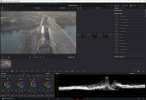
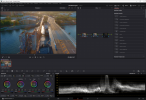
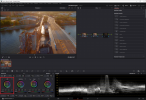
For the final step I would adjust the curves since this is a low contrast scene due to the sunset so I would add back contrast via the curves and the final image would look like below:
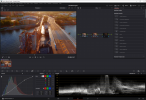
Last edited:
Saladshooter
Well-Known Member
- Joined
- Aug 25, 2021
- Messages
- 182
- Reaction score
- 177
- Age
- 52
Once again, thank you for your insightful help @herein2021. Your example is a great tutorial in warming the scene to your liking and vision.
The light conditions here in New England are constantly challenged because of deep shadows thrown by our hills and the amount of exposure can change drastically while in flight as I move in and out of the shadows as I travel down the river valley that dominates my area. Direct overhead sun provides the most consistent video. I find myself often cutting up my footage into shorter clips so that I can process the lighting differently when the light abruptly changes during flight.
Even when applying the techniques you employ, the blue cast remains in the shadows while changing the overall look of the video. I am getting better results by first working on the white balance and very slightly adjusting the reds using gain or lift. Even though these changes are global and not targeting the shadows, they improve the accuracy of the colors in the scene, which reduces the amount of blue evident in the shaded areas. I have much improved examples of the river scene that I provided.
For most of the editing I do, I am trying to produce a scene that looks natural and not overly stylized. All three of my primary drones present challenges. The EVO 2 PRO has the issue discussed above. The Skydio 2 has the very accurate colors out of camera but doesn't do LOG and the DJI Air 2S exaggerates greens and has to be reined in.
The light conditions here in New England are constantly challenged because of deep shadows thrown by our hills and the amount of exposure can change drastically while in flight as I move in and out of the shadows as I travel down the river valley that dominates my area. Direct overhead sun provides the most consistent video. I find myself often cutting up my footage into shorter clips so that I can process the lighting differently when the light abruptly changes during flight.
Even when applying the techniques you employ, the blue cast remains in the shadows while changing the overall look of the video. I am getting better results by first working on the white balance and very slightly adjusting the reds using gain or lift. Even though these changes are global and not targeting the shadows, they improve the accuracy of the colors in the scene, which reduces the amount of blue evident in the shaded areas. I have much improved examples of the river scene that I provided.
For most of the editing I do, I am trying to produce a scene that looks natural and not overly stylized. All three of my primary drones present challenges. The EVO 2 PRO has the issue discussed above. The Skydio 2 has the very accurate colors out of camera but doesn't do LOG and the DJI Air 2S exaggerates greens and has to be reined in.
GeoDrone SRL
Well-Known Member
- Joined
- Aug 18, 2021
- Messages
- 490
- Reaction score
- 273
- Age
- 48
Try
Try Neat advanced options and clear using RGB, in your case only B channel.Once again, thank you for your insightful help @herein2021. Your example is a great tutorial in warming the scene to your liking and vision.
The light conditions here in New England are constantly challenged because of deep shadows thrown by our hills and the amount of exposure can change drastically while in flight as I move in and out of the shadows as I travel down the river valley that dominates my area. Direct overhead sun provides the most consistent video. I find myself often cutting up my footage into shorter clips so that I can process the lighting differently when the light abruptly changes during flight.
Even when applying the techniques you employ, the blue cast remains in the shadows while changing the overall look of the video. I am getting better results by first working on the white balance and very slightly adjusting the reds using gain or lift. Even though these changes are global and not targeting the shadows, they improve the accuracy of the colors in the scene, which reduces the amount of blue evident in the shaded areas. I have much improved examples of the river scene that I provided.
For most of the editing I do, I am trying to produce a scene that looks natural and not overly stylized. All three of my primary drones present challenges. The EVO 2 PRO has the issue discussed above. The Skydio 2 has the very accurate colors out of camera but doesn't do LOG and the DJI Air 2S exaggerates greens and has to be reined in.
herein2021
Well-Known Member
Once again, thank you for your insightful help @herein2021. Your example is a great tutorial in warming the scene to your liking and vision.
The light conditions here in New England are constantly challenged because of deep shadows thrown by our hills and the amount of exposure can change drastically while in flight as I move in and out of the shadows as I travel down the river valley that dominates my area. Direct overhead sun provides the most consistent video. I find myself often cutting up my footage into shorter clips so that I can process the lighting differently when the light abruptly changes during flight.
Even when applying the techniques you employ, the blue cast remains in the shadows while changing the overall look of the video. I am getting better results by first working on the white balance and very slightly adjusting the reds using gain or lift. Even though these changes are global and not targeting the shadows, they improve the accuracy of the colors in the scene, which reduces the amount of blue evident in the shaded areas. I have much improved examples of the river scene that I provided.
For most of the editing I do, I am trying to produce a scene that looks natural and not overly stylized. All three of my primary drones present challenges. The EVO 2 PRO has the issue discussed above. The Skydio 2 has the very accurate colors out of camera but doesn't do LOG and the DJI Air 2S exaggerates greens and has to be reined in.
You could get more detailed and target the exact color you want more directly using Power Windows, Selective Color, and other techniques like that; but personally I don't bother. I am not shooting Hollywood blockbusters and the footage the EVO II produces with minimal post processing is good enough for my clients so its good enough for me.
Over the years I've realized life is too short to spend hours of unpaid time trying to perfect every pixel. I can assure you that the only one bothered by this issue is probably you. At the end of the day we are working with a truly tiny camera sensor and highly compressed video files that can only do so much. I would also check to ensure your monitor is properly calibrated, your monitor could be adding more blue than is there and affecting your perception of the colors.
As far as rapidly changing lighting conditions; I deal with that as well; here in FL most days there are clouds rapidly going past the sun causing the color temp to change by over 1000 Kelvin within a few min. Personally I typically only need a few seconds of drone video for a larger video project so I just wait for the sun to come back out or I expose for the few seconds or 60 seconds that I need. Photos are actually harder because for the bigger commercial real estate jobs they want all of the images to look consistent but if one image is sunny they want them all to be sunny which can be easier said than done at times.
Saladshooter
Well-Known Member
- Joined
- Aug 25, 2021
- Messages
- 182
- Reaction score
- 177
- Age
- 52
That is the truth.... but I am filming primarily for myself at the moment while perfect drone moves and collecting footage for a project I am building up to, so I can afford to be picky and work on the image quality. I do obsess over the look of my video, trying to develop a method of grading that is simple and can be done with very few mouse clicks. It annoys me when I can't make a problem disappear and the EVO 2 PRO presents me with a challenge I haven't quite been able to overcome.I can assure you that the only one bothered by this issue is probably you
Correctly displayed colors are important to me...... ask my poor wife about the five or six televisions I returned before I was happy with the deep blacks and accuracy within the Rec. 709 color space... and even then I had to have it professionally calibrated before I was satisfied.
When I move to selling my product I will have to give up the time wasted on unnecessary corrections but I am hoping I will have a firm enough grasp of the techniques needed for quick edits and good output.
herein2021
Well-Known Member
I know exactly what you mean, I am not quite that picky, but I did spend many hours perfecting my work flow to be as efficient as possible while still achieving what I considered acceptable results.That is the truth.... but I am filming primarily for myself at the moment while perfect drone moves and collecting footage for a project I am building up to, so I can afford to be picky and work on the image quality. I do obsess over the look of my video, trying to develop a method of grading that is simple and can be done with very few mouse clicks. It annoys me when I can't make a problem disappear and the EVO 2 PRO presents me with a challenge I haven't quite been able to overcome.
Correctly displayed colors are important to me...... ask my poor wife about the five or six televisions I returned before I was happy with the deep blacks and accuracy within the Rec. 709 color space... and even then I had to have it professionally calibrated before I was satisfied.
When I move to selling my product I will have to give up the time wasted on unnecessary corrections but I am hoping I will have a firm enough grasp of the techniques needed for quick edits and good output.
If it is possible to fix the image to your liking DR is definitely capable of doing it, as I am sure you are aware, it has been used to color grade nearly every Hollywood release since the 90's.
I recommend that you watch the DR training video titled "The art of color grading", I am sure that somewhere in there is the technique that you need to achieve what you want.
I have watched the video twice but only use a fraction of the techniques that they demonstrate in the video.
DaVinci Resolve – Training | Blackmagic Design
Professional video editing, color correction, visual effects and audio post production all in a single application. Free and paid versions for Mac, Windows and Linux.
www.blackmagicdesign.com
We are tq
All you have to do is warm up the lows vs changing the WB. That will fix it in 2 seconds and not affect the mids or highs.
I never deliver at data rates that high, that would result in huge files. Even DVD quality is only 10Mb/s. I typically stick to 20Mb/s for H.264 MP4 deliveries which is also the optimal data rate for YouTube at 4K.
Gents, my observation is like this. Log and Autel LUT is enough for me. Of course I am trying to modifying this lut to get better look for me. Depends of the sun. But in my opinion LOG at night is very noisy. Sharp but with a lot of noise. What settings are for you best at night, when low light is around?
Here from start is with 1/60 shutter priority iso 800. From 25 sec is LOG. What do you think?
Here from start is with 1/60 shutter priority iso 800. From 25 sec is LOG. What do you think?
Last edited:
herein2021
Well-Known Member
Gents, my observation is like this. Log and Autel LUT is enough for me. Of course I am trying to modifying this lut to get better look for me. Depends of the sun. But in my opinion LOG at night is very noisy. Sharp but with a lot of noise. What settings are for you best at night, when low light is around?
Here from start is with 1/60 shutter priority iso 800. From 25 sec is LOG. What do you think?
I personally never use LUTs for the base Rec709 grade. I always grade the primaries by hand then apply a creative LUT for the whole project to make all of the footage look cohesive. My night settings are Daylight WB, 1/30 shutter, ISO 800, ALOG, F2.8. These are the settings that I used for all of the night footage in my Explore Your World Autel EVO II 6K video:
To reduce the noise at night, I use 1/30s to gain a stop of light then bring down the lows in the primaries to set the blackpoint lower which reduces the noise.
GeoDrone SRL
Well-Known Member
- Joined
- Aug 18, 2021
- Messages
- 490
- Reaction score
- 273
- Age
- 48
My settings for night (2h after sunset):
LOG
ISO 3200
SS: 1/25
FPS: 25 (Europe, light freq = 50Hz)
Manual WB: 2700 - 3000K
Auto Focus blocked.
The image can be cleaned by Resolve with Noise reduction. Lower the black point in diagram, increase a little shadows with S curve. The dark shadows recover pretty well, still for a Pro footage you need to go probably to ISO 1600 for cleaner image, not 3200 like i did.
I had no time to work with image, is almost RAW, sorry for this but the point is to see the lights in mid and low shadows... So please don't pay attention to details and WB, were not fixed .
.
LOG
ISO 3200
SS: 1/25
FPS: 25 (Europe, light freq = 50Hz)
Manual WB: 2700 - 3000K
Auto Focus blocked.
The image can be cleaned by Resolve with Noise reduction. Lower the black point in diagram, increase a little shadows with S curve. The dark shadows recover pretty well, still for a Pro footage you need to go probably to ISO 1600 for cleaner image, not 3200 like i did.
I had no time to work with image, is almost RAW, sorry for this but the point is to see the lights in mid and low shadows... So please don't pay attention to details and WB, were not fixed
herein2021
Well-Known Member
My settings for night (2h after sunset):
LOG
ISO 3200
SS: 1/25
FPS: 25 (Europe, light freq = 50Hz)
Manual WB: 2700 - 3000K
Auto Focus blocked.
The image can be cleaned by Resolve with Noise reduction. Lower the black point in diagram, increase a little shadows with S curve. The dark shadows recover pretty well, still for a Pro footage you need to go probably to ISO 1600 for cleaner image, not 3200 like i did.
I had no time to work with image, is almost RAW, sorry for this but the point is to see the lights in mid and low shadows... So please don't pay attention to details and WB, were not fixed.
Of course everyone has their own taste, but personally I like night footage to be dark, I want the camera to see no better at night than the human eyes so I have no problems letting under exposed areas drop to black if that's how it would look to the human eye. To me anything over ISO 800 is too noisy and is showing more detail than the human eye would. Yes the noise can be cleaned up but the process reduces contrast and makes everything in the footage softer. I have no problems with setting the black point to crushed black at night because that's how the human eye would see it.
A lot of people use the ISO to try to "see" where there is no light, but for my own personal style, this does not look natural and introduces too much noise in the video. I even favor shooting at ISO 400 at night if the drone is close enough to bright enough city lights, where there's no light I want to be just as dark as the original scene.
Similar threads
- Replies
- 7
- Views
- 510
- Replies
- 17
- Views
- 3K
- Replies
- 1
- Views
- 108
- Replies
- 1
- Views
- 118
- Replies
- 1
- Views
- 834
Latest threads
-
-
-
-
Autel 640t Enterprise Lite „OA (Obstacle avoidance) abnormal“ drone became not responsive.
- Started by LexusWorld
- Replies: 0
-


